6 MOCK ICE HOUSES FOR BRAYS BAYOU, AS PROPOSED BY THAT GUY WHO TAKES PHOTOS OF HOUSTON ICE HOUSES 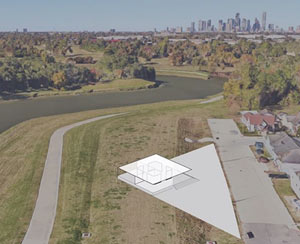 That massively expanded greenway network is all well and good, suggests architect and icehouse photographer-philosopher David Richmond in the Chronicle today — but bayouside trails are a lot better at getting people from up and down the waterways to run right past one another than they are at getting the same folks to mix or hang out. Richmond offers a suggestion to change that: a design for a boxy, glassy pavilion structure loosely inspired by the shape of, and what he argues is the historic social function of, Houston’s icehouses — namely, as a stand-in for the kind of town squares that he says most of Houston doesn’t really have. Richmond proposes sticking the same square design in 6 different spots along Brays Bayou, with each structure’s range of possible uses (from flea markets and coffee shops to movie nights and wedding receptions) being tailored to fit the surrounding area. [Houston Chronicle] Speculative rendering of pavilion structure along Brays Bayou: David Richmond
That massively expanded greenway network is all well and good, suggests architect and icehouse photographer-philosopher David Richmond in the Chronicle today — but bayouside trails are a lot better at getting people from up and down the waterways to run right past one another than they are at getting the same folks to mix or hang out. Richmond offers a suggestion to change that: a design for a boxy, glassy pavilion structure loosely inspired by the shape of, and what he argues is the historic social function of, Houston’s icehouses — namely, as a stand-in for the kind of town squares that he says most of Houston doesn’t really have. Richmond proposes sticking the same square design in 6 different spots along Brays Bayou, with each structure’s range of possible uses (from flea markets and coffee shops to movie nights and wedding receptions) being tailored to fit the surrounding area. [Houston Chronicle] Speculative rendering of pavilion structure along Brays Bayou: David Richmond
Quicklink
‘666 GET OUT’ HOUSE DRAWS IN A BUYER ANYWAY 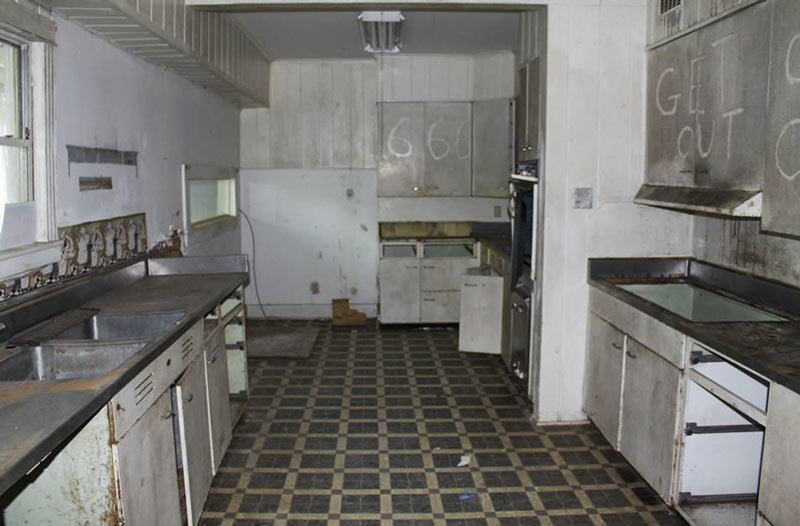 The 3-bedroom, 2-bath house up in Longview, TX, listed with spooky pronouncements like “666†and “GET OUT†smeared into the veneer of dirt in its kitchen (as recently seen on Swamplot’s Home Listing Photo of the Day feature) — was sold last week “to a buyer over the phone who had never seen the property in person, just the online listing,†Heather Leighton of the Chronicle reports. The cryptic messages, which turned out to be pretty killer marketing, were put in place by the previous owners to deter break-ins. Although seller Amy Tabor of H5 Auction and Realty says the writing initially creeped her out, it did not deter her from selling the house to the highest bidder at last Monday’s auction (which started at $2,500). The company’s Facebook note about the home, which made no secret of the property’s decaying, peeling “fixer upper†conditions, simply urged buyers to “channel your inner Joanna Gaines†—- and received 88 percent more action than a normal post for the company. [Houston Chronicle; previously on Swamplot] Photo of 642 Sylvan Dr.: HAR
The 3-bedroom, 2-bath house up in Longview, TX, listed with spooky pronouncements like “666†and “GET OUT†smeared into the veneer of dirt in its kitchen (as recently seen on Swamplot’s Home Listing Photo of the Day feature) — was sold last week “to a buyer over the phone who had never seen the property in person, just the online listing,†Heather Leighton of the Chronicle reports. The cryptic messages, which turned out to be pretty killer marketing, were put in place by the previous owners to deter break-ins. Although seller Amy Tabor of H5 Auction and Realty says the writing initially creeped her out, it did not deter her from selling the house to the highest bidder at last Monday’s auction (which started at $2,500). The company’s Facebook note about the home, which made no secret of the property’s decaying, peeling “fixer upper†conditions, simply urged buyers to “channel your inner Joanna Gaines†—- and received 88 percent more action than a normal post for the company. [Houston Chronicle; previously on Swamplot] Photo of 642 Sylvan Dr.: HAR
COMMENT OF THE DAY: ASPIRATIONAL HOUSTON DEVELOPMENT NAMING JUST AIN’T WHAT IT USED TO BE  “‘Heights creep’ is to the 2010s what ‘River Oaks creep’ was to the 1980s/90s. Back in the 90s when I was living in a (moderately crappy) apartment near the corner of Kirby and Westheimer, anything between Buffalo Bayou, the West Loop, US-59 and Montrose might have been referred to as River Oaks. Hell, even the River Oaks Shopping Center isn’t even actually in River Oaks.” [Angostura, commenting on Putting the Heights Back In Its . . . Uh, Places; previously on Swamplot] Photo: River Oaks Theater
“‘Heights creep’ is to the 2010s what ‘River Oaks creep’ was to the 1980s/90s. Back in the 90s when I was living in a (moderately crappy) apartment near the corner of Kirby and Westheimer, anything between Buffalo Bayou, the West Loop, US-59 and Montrose might have been referred to as River Oaks. Hell, even the River Oaks Shopping Center isn’t even actually in River Oaks.” [Angostura, commenting on Putting the Heights Back In Its . . . Uh, Places; previously on Swamplot] Photo: River Oaks Theater
PUTTING THE HEIGHTS BACK IN ITS . . . UH, PLACES  “In their rush to capitalize on the popularity of the district, businesses and developers have awkwardly assumed the mantle of the name ‘Heights,’ even though they’re clearly outside the zone of its accepted borders,” writes Jeff Balke this morning for the Houston Press. Where exactly are those accepted borders? And which variation means what? Balke suggests something between a taxonomical scheme and an etiquette lesson on selecting the proper name for whatever flavor of Heights, Heights-adjacent and Heights-aspiring territory you may be seeking to invoke — from the historic city originally spurring the name, all the way to the fringe territories of Katyville and the Heights Walmart. [Houston Press; previously on Swamplot] Photo: Swamplot inbox
“In their rush to capitalize on the popularity of the district, businesses and developers have awkwardly assumed the mantle of the name ‘Heights,’ even though they’re clearly outside the zone of its accepted borders,” writes Jeff Balke this morning for the Houston Press. Where exactly are those accepted borders? And which variation means what? Balke suggests something between a taxonomical scheme and an etiquette lesson on selecting the proper name for whatever flavor of Heights, Heights-adjacent and Heights-aspiring territory you may be seeking to invoke — from the historic city originally spurring the name, all the way to the fringe territories of Katyville and the Heights Walmart. [Houston Press; previously on Swamplot] Photo: Swamplot inbox
COMMENT OF THE DAY: I AM A METRO RIDER, I CONTAIN MULTITUDES  “There are valid reasons for the increase in boardings, which sound like a lot but are only +4.65 percent year-over-year. FYI — a boarding is counted every time that a person steps across the threshold of a transit vehicle . . . To put things in perspective, that means that if I’m a park-and-ride commuter and I have to make 2 transfers each way every day of a 5-day work week to get where I’m going, I count for 30 boardings per week and 1,500 boardings per fifty-workweek year. It’d only take 60,000 of me to account for all of METRO’s users. That isn’t to try to generalize about their user base, but it is to demonstrate that not all boardings are created equal, and that the circumstances of even some modest fraction of super-users can easily help to make these big numbers possible.” [TheNiche, commenting on First Signs of This Year’s Sargassum Seaweed Invasion; Houston’s Top Crime Spots]
“There are valid reasons for the increase in boardings, which sound like a lot but are only +4.65 percent year-over-year. FYI — a boarding is counted every time that a person steps across the threshold of a transit vehicle . . . To put things in perspective, that means that if I’m a park-and-ride commuter and I have to make 2 transfers each way every day of a 5-day work week to get where I’m going, I count for 30 boardings per week and 1,500 boardings per fifty-workweek year. It’d only take 60,000 of me to account for all of METRO’s users. That isn’t to try to generalize about their user base, but it is to demonstrate that not all boardings are created equal, and that the circumstances of even some modest fraction of super-users can easily help to make these big numbers possible.” [TheNiche, commenting on First Signs of This Year’s Sargassum Seaweed Invasion; Houston’s Top Crime Spots]
ELYSIAN VIADUCT WORK UNEARTHS HISTORIC HOUSTON HERITAGE TRASH PILE 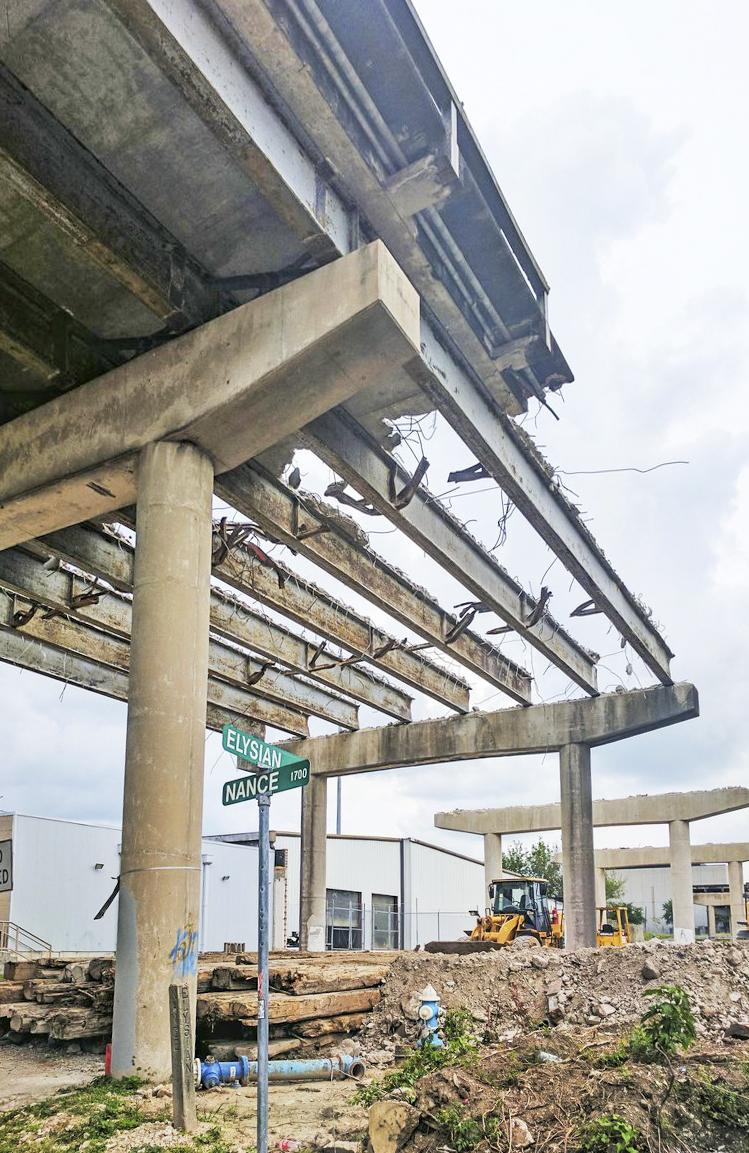 The real value of the long-buried dump uncovered by the ongoing replacement of the Elysian St. bridge over I-10 and Buffalo Bayou, write Doug Boyd and Jason Barrett this week in the Chronicle, is in the opportunity it provides “to document the often-unwritten parts of our industrial heritage.” The dump, apparently built up over the early half of the 1900s in a former gully, serves as a springboard for the authors to talk trash — Houston, they write, was one of the first cities to adopt widespread municipal garbage incineration, and lagged decades behind as most cities chose to stop doing it out of concern for public health. Spots like the one under Elysian St., they add, help fill in the gaps of knowledge of what happened to all the other trash that didn’t end up in a city incinerator or landfill — and who tended to live nearby. [Houston Chronicle; previously on Swamplot]  Photos: Adam J Williams
The real value of the long-buried dump uncovered by the ongoing replacement of the Elysian St. bridge over I-10 and Buffalo Bayou, write Doug Boyd and Jason Barrett this week in the Chronicle, is in the opportunity it provides “to document the often-unwritten parts of our industrial heritage.” The dump, apparently built up over the early half of the 1900s in a former gully, serves as a springboard for the authors to talk trash — Houston, they write, was one of the first cities to adopt widespread municipal garbage incineration, and lagged decades behind as most cities chose to stop doing it out of concern for public health. Spots like the one under Elysian St., they add, help fill in the gaps of knowledge of what happened to all the other trash that didn’t end up in a city incinerator or landfill — and who tended to live nearby. [Houston Chronicle; previously on Swamplot]  Photos: Adam J Williams
HUNKY DORY AND BERNADINE’S ARE SHUTTING DOWN NEXT WEEK AFTER ALL 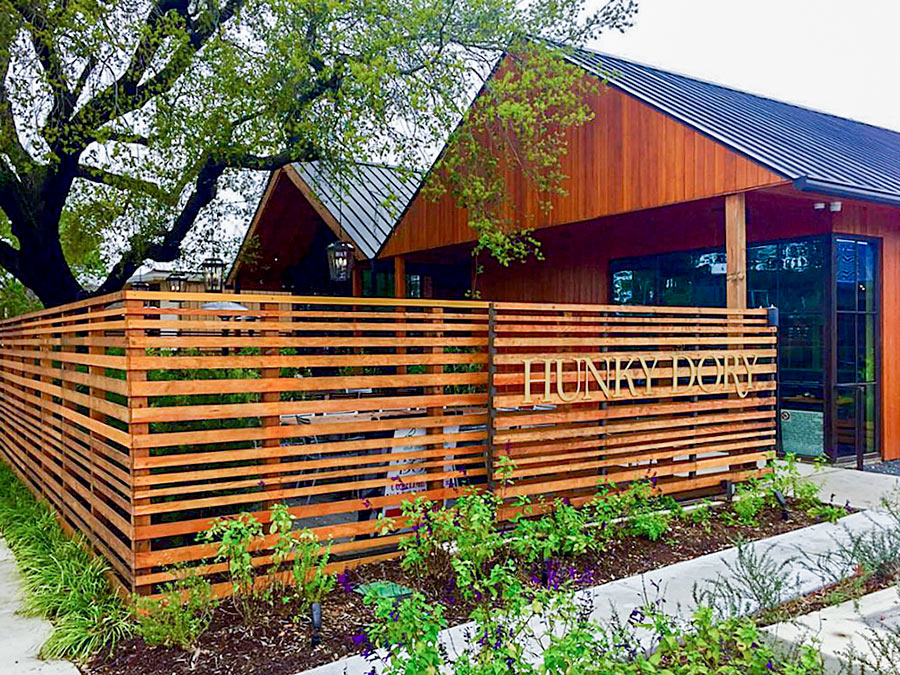 The scandal– and bankruptcy-embroiled Treadsack Group just announced that both Hunky Dory Tavern and Bernadine’s are closing next week. After the company announced in late March that both restaurants would stay open for the time being, the last day of action for each is now set as May 24th. The expanding group of Killen’s meat vendors announced on Monday that it had snagged Bernadine’s chef Graham Laborde (who stepped in to run Hunky Dory’s kitchen too, after Richard Knight left in February). No related updates from also-in-Chapter-11 Down House, or any of the other restaurants in the group. [Previously on Swamplot] Photo: Hunky Dory
The scandal– and bankruptcy-embroiled Treadsack Group just announced that both Hunky Dory Tavern and Bernadine’s are closing next week. After the company announced in late March that both restaurants would stay open for the time being, the last day of action for each is now set as May 24th. The expanding group of Killen’s meat vendors announced on Monday that it had snagged Bernadine’s chef Graham Laborde (who stepped in to run Hunky Dory’s kitchen too, after Richard Knight left in February). No related updates from also-in-Chapter-11 Down House, or any of the other restaurants in the group. [Previously on Swamplot] Photo: Hunky Dory
LYFT PREPARES TO DIVE BACK INTO HOUSTON, WOOS DISGRUNTLED UBER DRIVERS AT IAH 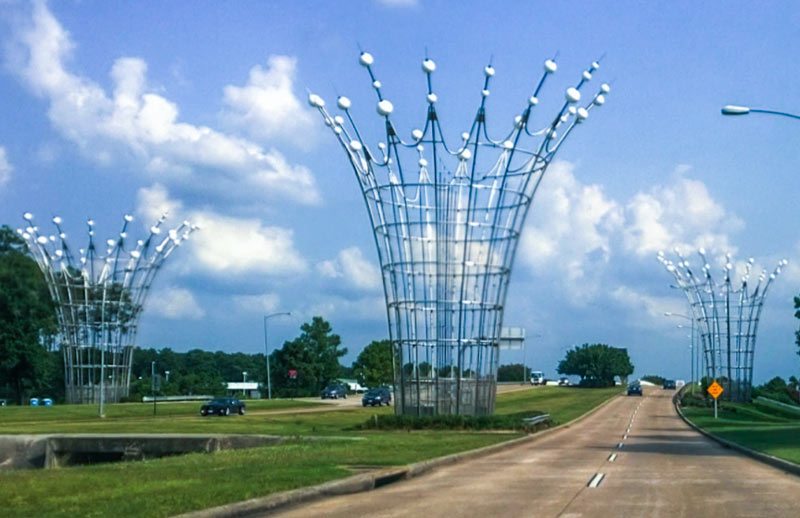 Barring an out of character veto from governor Greg Abbott, that Texas law that Uber and Lyft have been angling for (the one that would stop cities from requiring more stringent background checks on their rideshare drivers, like Houston did) should go into effect shortly, now that the state Senate has passed the measure with more than 2 thirds support. Lyft pulled out of Houston in late 2014 over the local rule change, while Uber just made some noise about doing so. Meagan Flynn reports for the Press that a Lyft rep was spotted in a waiting lot at IAH on Monday passing out business cards to Uber drivers, some of whom were on a brief strike over wages and company policies. The rep said the company would be back in town soon, if the bill becomes law; the company has also put out a few job ads for Houston operations staff. [Houston Press; previously on Swamplot] Photo of Radiant Fountains sculptures near IAH: elnina via Swamplot Flickr Pool
Barring an out of character veto from governor Greg Abbott, that Texas law that Uber and Lyft have been angling for (the one that would stop cities from requiring more stringent background checks on their rideshare drivers, like Houston did) should go into effect shortly, now that the state Senate has passed the measure with more than 2 thirds support. Lyft pulled out of Houston in late 2014 over the local rule change, while Uber just made some noise about doing so. Meagan Flynn reports for the Press that a Lyft rep was spotted in a waiting lot at IAH on Monday passing out business cards to Uber drivers, some of whom were on a brief strike over wages and company policies. The rep said the company would be back in town soon, if the bill becomes law; the company has also put out a few job ads for Houston operations staff. [Houston Press; previously on Swamplot] Photo of Radiant Fountains sculptures near IAH: elnina via Swamplot Flickr Pool
COMING OFF THE STATE WATCHLIST DOESN’T MEAN HOUSTON’S POLLUTION HOTSPOTS DON’T STILL NEED TO BE WATCHED  Of the 14 sites pulled off the Texas Commission for Environmental Quality’s special pollution watchlist since 2007, Elena Craft writes in the Chronicle’s Gray Matters column today, some 8 of them have since had new noteworthy upticks of various chemicals linked to health issues like breathing problems, nerve problems, or cancer, according to the Environmental Defense Fund’s recent study. Craft dives into some of the sticky aspects of trying to keep track of whether chemical levels are above normal for visitors and residents near spots like Milby Park (above) and the Lynchburg Ferry area, including the fact that the data collected by on-site monitors isn’t always available to the public right away, and that short-term high levels of problem chemicals don’t usually get investigated. “The absence of information about these seemingly random pollution spikes is troubling,” Craft writes, “because it suggests that TCEQ has stopped paying attention before its work is truly complete.” [Houston Chronicle; previously on Swamplot] Photo of Milby Park: Ric F.
Of the 14 sites pulled off the Texas Commission for Environmental Quality’s special pollution watchlist since 2007, Elena Craft writes in the Chronicle’s Gray Matters column today, some 8 of them have since had new noteworthy upticks of various chemicals linked to health issues like breathing problems, nerve problems, or cancer, according to the Environmental Defense Fund’s recent study. Craft dives into some of the sticky aspects of trying to keep track of whether chemical levels are above normal for visitors and residents near spots like Milby Park (above) and the Lynchburg Ferry area, including the fact that the data collected by on-site monitors isn’t always available to the public right away, and that short-term high levels of problem chemicals don’t usually get investigated. “The absence of information about these seemingly random pollution spikes is troubling,” Craft writes, “because it suggests that TCEQ has stopped paying attention before its work is truly complete.” [Houston Chronicle; previously on Swamplot] Photo of Milby Park: Ric F.
COMMENT OF THE DAY: AT LEAST THERE’S A LITTLE SOMETHING TO BRAG ABOUT LEFT IN UPTOWN  “Well, at least I am glad they recognized and saved the [Morse-Bragg] cemetery. It is a shame there is nothing left close by to reflect the history of the mill, or cotton gin. Nice to imagine incorporating [some] coffee shops [or] restaurants around a small museum as part of Uptown. For those who are not familiar with the area, it is on a street called Wynden Drive (43 S Wynden Dr.).” [MontroseResident, commenting on Texas Leads in Housing Starts; Houston Home Prices Shoot Up; previously on Swamplot] Illustration: Lulu
“Well, at least I am glad they recognized and saved the [Morse-Bragg] cemetery. It is a shame there is nothing left close by to reflect the history of the mill, or cotton gin. Nice to imagine incorporating [some] coffee shops [or] restaurants around a small museum as part of Uptown. For those who are not familiar with the area, it is on a street called Wynden Drive (43 S Wynden Dr.).” [MontroseResident, commenting on Texas Leads in Housing Starts; Houston Home Prices Shoot Up; previously on Swamplot] Illustration: Lulu
SAN JACINTO MALL ANCHORS CAUSING REDO PLANS TO DRAG 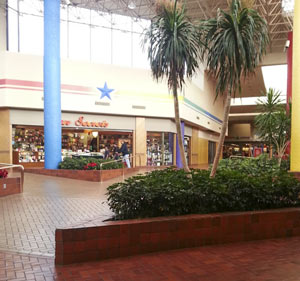 “It’s been slow and tedious — We didn’t count on the myriad problems all the traditional mall department stores are having,” Alan Hassenflu of Fidelis Realty Partners tells Katherine Blunt this week in the Chronicle, while discussing the company’s stagnating attempt to redo Baytown’s San Jacinto Mall. The company’s plans to knock down and rebuild the mall after buying it last summer are running up against drawn-out negotiations with tenants who signed restrictive covenants back in the early 80’s — agreements which can mean developers have to get those tenants to okay changes to the mall, and which can last for decades longer than original operating agreements. “In the case of San Jacinto,” writes Blunt, “the 3 remaining department stores have occupied their buildings for far longer than required under the operating agreements. But the restrictive covenants remain in place, giving them the some control over the mall’s future.” [Houston Chronicle; previously on Swamplot] Photo: Ray D.
“It’s been slow and tedious — We didn’t count on the myriad problems all the traditional mall department stores are having,” Alan Hassenflu of Fidelis Realty Partners tells Katherine Blunt this week in the Chronicle, while discussing the company’s stagnating attempt to redo Baytown’s San Jacinto Mall. The company’s plans to knock down and rebuild the mall after buying it last summer are running up against drawn-out negotiations with tenants who signed restrictive covenants back in the early 80’s — agreements which can mean developers have to get those tenants to okay changes to the mall, and which can last for decades longer than original operating agreements. “In the case of San Jacinto,” writes Blunt, “the 3 remaining department stores have occupied their buildings for far longer than required under the operating agreements. But the restrictive covenants remain in place, giving them the some control over the mall’s future.” [Houston Chronicle; previously on Swamplot] Photo: Ray D.
LAWSUIT ALREADY FILED OVER THE TENT BAN THAT TOOK EFFECT FRIDAY 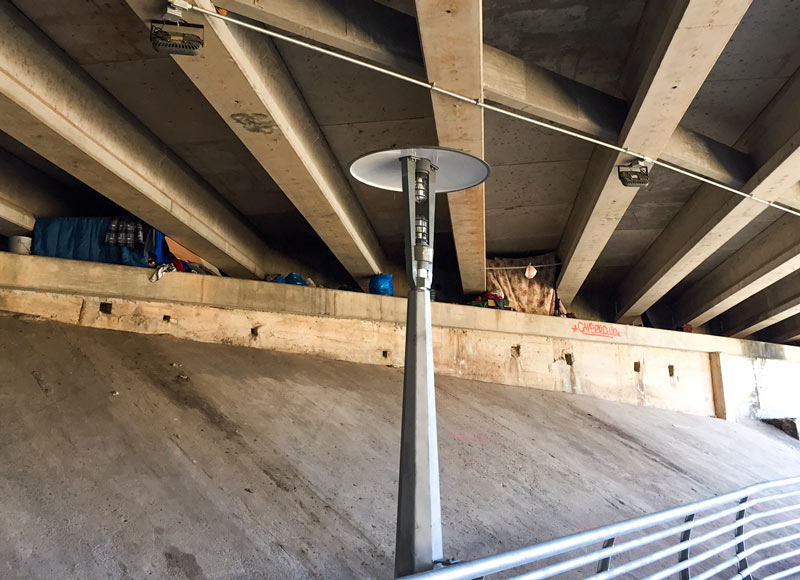 This morning the Texas ACLU filed for an injunction on the City’s new ordinances aimed at Houston’s homeless folks and panhandlers, Meagan Flynn reports this afternoon for the Houston Press. The new rules (which among other things ban sleeping in tents or boxes, make it illegal to possess a grill or more than a 3-by-3-by-3-foot box’s worth of stuff in public, and prohibit panhandling close to people, ATMs and payphones) went into effect on Friday. An ACLU staff attorney said in a statement that the rules step away from Houston’s previously “humane approach” to reducing homelessness, adding that “they’re meant to get people into shelters with ‘tough love,’ but the truth is the shelters are full and Houston’s homeless have nowhere else to go.†Flynn points out that the Coalition for the Homeless’s homeless count last year estimated that only 164 shelter beds were vacant on a night when 1,046 people were sleeping on the streets. [Houston Press; previously on Swamplot] Photo of previously cleared homeless encampment under Louisiana St. Bridge downtown: Christine Wilson
This morning the Texas ACLU filed for an injunction on the City’s new ordinances aimed at Houston’s homeless folks and panhandlers, Meagan Flynn reports this afternoon for the Houston Press. The new rules (which among other things ban sleeping in tents or boxes, make it illegal to possess a grill or more than a 3-by-3-by-3-foot box’s worth of stuff in public, and prohibit panhandling close to people, ATMs and payphones) went into effect on Friday. An ACLU staff attorney said in a statement that the rules step away from Houston’s previously “humane approach” to reducing homelessness, adding that “they’re meant to get people into shelters with ‘tough love,’ but the truth is the shelters are full and Houston’s homeless have nowhere else to go.†Flynn points out that the Coalition for the Homeless’s homeless count last year estimated that only 164 shelter beds were vacant on a night when 1,046 people were sleeping on the streets. [Houston Press; previously on Swamplot] Photo of previously cleared homeless encampment under Louisiana St. Bridge downtown: Christine Wilson
COMMENT OF THE DAY: LAY OFF THOSE FLOODED UNDERGROUND FREEWAYS, THEY’RE JUST DOING THEIR JOB  “Trenched roads include sumps that are capable of keeping the roadways from flooding from ordinary rain events, but are designed to become flooded in an emergency, acting as additional stormwater detention. Every cubic foot of stormwater that goes in there is a cubic foot that isn’t at the same elevation as city streets, businesses, and houses. It is a feature, not a bug.” [TheNiche, commenting on Watch as Unfunded Parks Appear on Top of Houston Freeways Before Your Very Eyes!]
“Trenched roads include sumps that are capable of keeping the roadways from flooding from ordinary rain events, but are designed to become flooded in an emergency, acting as additional stormwater detention. Every cubic foot of stormwater that goes in there is a cubic foot that isn’t at the same elevation as city streets, businesses, and houses. It is a feature, not a bug.” [TheNiche, commenting on Watch as Unfunded Parks Appear on Top of Houston Freeways Before Your Very Eyes!]
DOWNTOWN TO GET A SECOND FOOD HALL, THIS TIME ABOVE GROUND 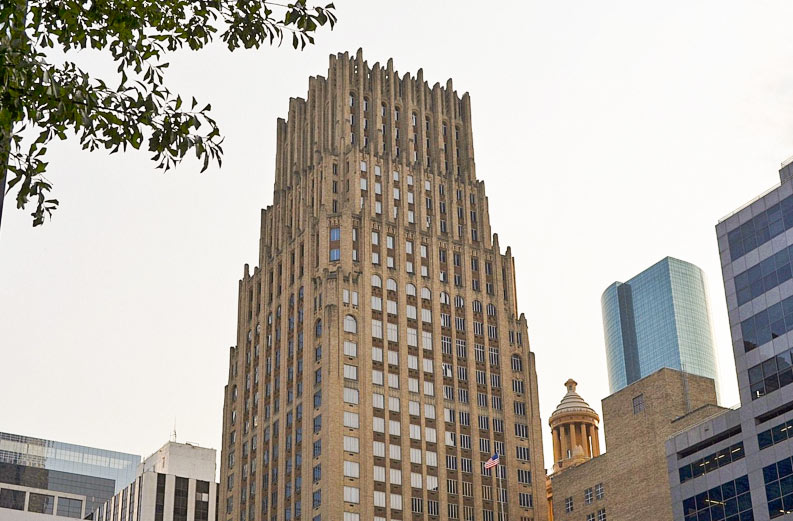 The former Gulf Oil building at 712 Main St. (now the JPMorgan Chase bulding, currently getting made over along with its nextdoor companion-in-rebranding as The Jones on Main) will get a new food hall, a rep from Lionstone announced last week. Greg Morago reports in the Chronicle that Midway and Lionstone are still seeking vendors for the space (and that the current name, The Food Hall on Main, will probably change). The hall will take up about 20,000 sq. ft. of the Chase building’s lobby, making it about 3 times larger than the leafy Conservatory that opened last spring some 2 blocks away — one of the few parts of Downtown’s underground food scene open after daytime business hours. The revamp to the pair of buildings will also include an art deco cocktail lounge. [Houston Chronicle; previously on Swamplot] Photo of 712 Main St.: elnina via Swamplot Flickr pool
The former Gulf Oil building at 712 Main St. (now the JPMorgan Chase bulding, currently getting made over along with its nextdoor companion-in-rebranding as The Jones on Main) will get a new food hall, a rep from Lionstone announced last week. Greg Morago reports in the Chronicle that Midway and Lionstone are still seeking vendors for the space (and that the current name, The Food Hall on Main, will probably change). The hall will take up about 20,000 sq. ft. of the Chase building’s lobby, making it about 3 times larger than the leafy Conservatory that opened last spring some 2 blocks away — one of the few parts of Downtown’s underground food scene open after daytime business hours. The revamp to the pair of buildings will also include an art deco cocktail lounge. [Houston Chronicle; previously on Swamplot] Photo of 712 Main St.: elnina via Swamplot Flickr pool
COMMENT OF THE DAY: RICE VILLAGE PARKING METER PUSHBACK PUSHBACK  “Don’t understand the hostility about parking meters. Visited the Briar Shoppe recently, easily found a spot to park, and it cost me a buck. One (1) dollar ($). Took a credit card, no change needed. There’s something else going on here.” [Gisgo, commenting on The Rice Village Plans To Remake Amherst St., Lure Shoppers Into an Alley] Photo of Rice Village parking meters: Matthew Landry
“Don’t understand the hostility about parking meters. Visited the Briar Shoppe recently, easily found a spot to park, and it cost me a buck. One (1) dollar ($). Took a credit card, no change needed. There’s something else going on here.” [Gisgo, commenting on The Rice Village Plans To Remake Amherst St., Lure Shoppers Into an Alley] Photo of Rice Village parking meters: Matthew Landry

